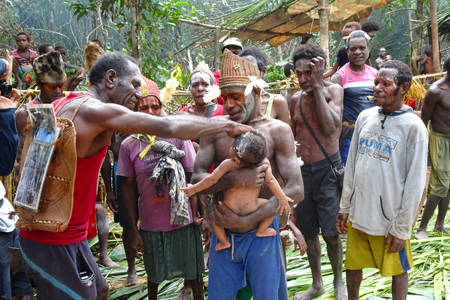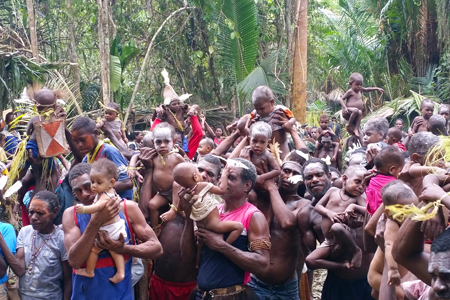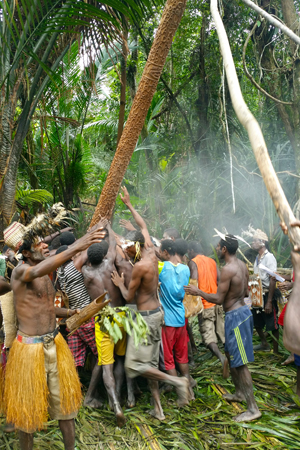1st Prize
Baptism in Sawa Erma, Asmat, Indonesian Papua
Much of my fieldwork in the Asmat area of Indonesian Papua was spent tracing the social implications of a dilemma that permeated the lives of my interlocutors. For Asmat people, the central question of communal life is how to ‘coordinate’ the competing demands of ancestral ritual, the Catholic church, and nation state, conceptualised as three potentially cross-cutting ‘hearths’ around which people gather.
These photos are from a baptism patterned on the structure and symbology of ancestral feasts. Like all Asmat feasts, baptismal liturgy involves the congregation of otherwise dispersed villagers, and ritualised, socially coordinated work that bridges various axes of segmentation in Asmat society. The feast’s peak, depicted here, centres around symbolic rebirth and naming, and the amassing and division of food items that emphasises villagers’ shared kindredness across inter-clan divides.
This innovative liturgy, developed since the 1980’s with the support of a Catholic diocese influenced by Vatican II’s culturally-appropriate approach to mission, is part of broader attempts by Asmat people to identify the word of God in the migration of their forebears. At stake here, villager leaders would say, is whether custom and Catholicism can be organised so that they ‘walk together’.
Name giving at the baptism.

This photo depicts name-giving, a key element of baptism. Here, the name-giver (left) announces the name of the child to his father (man holding the baby), his consanguineal kin (onlookers positioned behind him), and the village community at large. This name, potentially the name-giver’s own or that of his near kin, will be a source of strength for the child in his/her development. The name-giver anoints the child with sago, brought from the respective gardens of all participants in the form of individual sago balls, which have been crumbled and combined. The indivisibility of this unified mass of sago flour is iconic of the unity of the village as an inter-clan community and villagers’ shared history.
Praising God

After all the children were baptised, the families prayed and praised God by lifting their children into the air in the direction of the sun. The sun is an originary ancestor from a time in the village’s history when all the now-dispersed Asmat groups lived together prior to their division, enmity and historical migration to their present locations. Asmat liturgy is not oriented towards a salvational future, but rather towards this ancestral journey as both a source of strength and the grounds of unity for otherwise mutually-antagonistic Asmat groups.
Planting village names

In the final section of the liturgy, villagers erect a pole carved with the names of the newly baptised children. The top of the pole (out of shot) is carved into the figure of the bird that directed the villagers’ forebears from their point of origin on their ancestral migration, presenting these newly named children as progeny from this line of descent. The planting of the pole beside a sago tree (palm on the left), contributes to the fertility of the host’s garden. Guests who have gathered to baptise their children return home with a new coconut to plant for their child in their own garden, which is said to make the gardens ‘sacred’.
